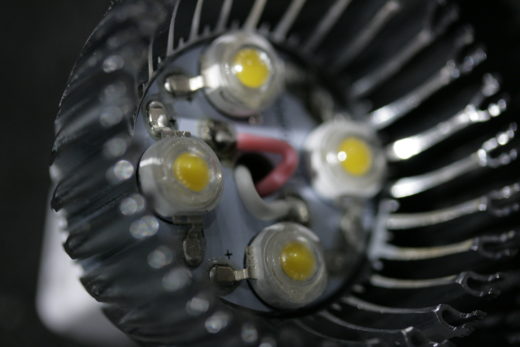
An issue we sometimes hit in camerawork is the potential inaccuracy of received wisdom. Sometimes people still refer to any colour quality issue as a “green spike,” because that’s the term which was broadly accurate for cheap fluorescent tubes. It’s like calling a vacuum cleaner a Hoover, and it causes problems, because if modern LED lights have anything, it’s a distinct lack of the blue-green that early fluorescents had to spare. Similarly, the idea of selecting a one-sixtieth of a second shutter to avoid lighting flicker has become part of filmmaking lore.
The trick people are recommending here relies on the assumption that the light is flickering at the local mains frequency. That was often true of fluorescent and gas discharge lighting as used in streets, sports arenas and neon signs. It used simple inductive components – copper wire wound on an iron core – so output would ramp up and down with the 50- or 60-cycle alternating current. It’s often said that tungsten lights don’t flicker, an idea which relies on the filament having enough bulk to stay hot between mains power cycles. In small bulbs that’s not always true, and the result can be a flickering of colour temperature, warm to cool 50 or 60 times a second.
Even modern LEDs can flicker. Being diodes, they only conduct when the power is flowing in one direction, which is only half the time with basic designs run on alternating current power. The resulting 25 or 30Hz flashing is a real migrane-generator, so many designs at least include circuitry to flip the negative-going part of the power so that the rate doubles to 50 or 60Hz. That’s more bearable but still stroboscopic, and might produce stripes on rolling shutter cameras, or a line of visible bright and dark bands in motion blur when we’re shooting fast-moving subjects.
Working around flicker
Those are the problems which can sometimes be worked-around with an appropriate selection of shutter speed. Shooting off-speed can make things complicated, but what causes the big, potentially unsolvable problems in modern practice, even at normal frame rates, stem from two main factors.
First, a lot of modern lighting – almost exclusively LEDs – is driven by electronics which are, to be fair, rather cost controlled. They may leak a significant amount of the mains frequency, so the light may dim and brighten at that frequency. Worse, though, they often have power conversion electronics that can work at almost any frequency that was convenient to the designer, so they may flicker at almost any rate, or even at a constantly drifting rate. Second, dimming modern domestic and industrial lighting often relies on pulse width modulation – turning the light on and off very quickly to reduce its brightness – which, again, can happen at almost any rate.
So, what’s the solution to all this?
There isn’t one. Modern technology has brought us amazingly power-efficient lighting, but that’s meant that every piece of practical lighting in a scene might conceivably be flickering at different rates, and worse, some of them may be flickering in ways that won’t show up until we start doing anything something of the ordinary like shooting off-speed. No camera setting, even the clever automated modes offered on some video cameras, can solve all the potential problems at once.
A reducing problem
Much as it may seem like all this is nothing but bad news, a lot of reasonable-quality modern LED lights are stabler than traditional technologies intended for the same application. Sports arenas and street lighting are among the most likely applications to have used gas discharge lighting which would flicker, whereas modern LED options may well not. They’ll have horrible colour quality, but then the things they replaced would also have had horrible colour quality, so overall they’re an improvement.
Testing is key. Use the intended camera, recorded in the intended way, at the intended frame rates and shutter angles, with the intended lighting. Movie lights should be OK – though beware some models which may have specific high-speed modes that may cost you some of their usual controllability if you need to shoot a thousand frames a second. Some colour and light meters have flicker assessment modes, and it’s possible to press a cellphone into service as a coarse flicker meter. Put the camera right up to a fluorescent tube, or point it right into a light, so that you see nothing but brightness, and it will select a very short shutter time. If dark bands appear there’s flicker (if horizontal dark bands don’t appear there may still be flicker, but the trick works to exclude things, at least).
Either way, magic numbers from a decades-old cinematographer’s data book are absolutely not a reliable solution, and haven’t been for a long time.
